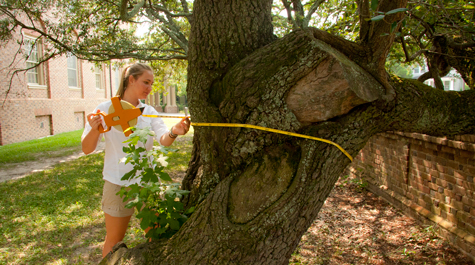Putting the trees onto the map
Elizabeth Saccoccia ’14 jams the end tab of a tape measure into a handy crevasse in the bark of a big holly tree behind Chandler Hall.
She walks around the thick trunk, making sure the tape stays at chest height and more or less perpendicular to the ground. She calls out the measurement of the circumference to Jim Perry, professor of marine science at VIMS. Perry writes the measurement down, along with the species and the tree’s precise location as indicated by his hand-held GPS unit.
Then it’s on to the next tree.
Saccoccia and Perry were collaborating on a survey of the most important trees on the verdant campus of William & Mary. Saccoccia takes her field notes to William & Mary’s Center for Geospatial Analysis, where she enters location of each of the campus’s significant trees.
The tree survey is only one part of an ongoing effort to identify and map environmental and cultural resources of the campus, says Wayne Boy, William & Mary’s director of planning, design and construction.
“We are creating campus map overlays for where utility and environmental and cultural features are on campus so that we know what we might impact when planning design and construction,” he said. The results of the tree survey will be plotted on one such campus map overlay. Another overlay shows known archaeological sites underground.
“We need the data for design coordination and also so we can properly plan and budget projects,” Boy explained.
Perry and Saccoccia aren’t logging every single tree on campus, but rather concentrating on two categories of significant trees. First of all, they’re noting the location of each of the memorial trees that have been planted to honor a person or a group.
“There’s more than 130 memorial trees all across campus,” Saccoccia said. “Some of them are pretty big. There are some trees over by William & Mary Hall that were planted in the Fifties.”
The second category is “specimen” trees, which Saccoccia says is a more subjective group.
“Jim (Perry) is the tree expert,” she said. “He’s the one that picks out the specimen trees. Basically, though, we look for big trees, rare trees, especially the big native species.”
In selecting trees for the survey, one group Perry keeps an eye out for is conifers. He explains that the conifers on campus represent all known genera of the cone bearers from around the world. “So we’re emphasizing recording all of the conifers in our survey,” he said. “We especially want to keep this collection intact.”
A double major in biology and geology, Saccoccia got involved in the tree survey as part of her work as an eco-ambassador. Eco ambassadors are appointed by the William & Mary Committee on Sustainability. Each eco-ambassador takes on a specific project. It begins with a one-credit course through the Environmental Science and Policy Program, taught by Sustainability Fellow Sarah Hanke ’10 and Professor Dennis Taylor, co-chair of the Committee on Sustainability.
“It’s a one-credit class that’s offered every semester and there’s different projects,” Saccoccia explained. “My project was working on the campus map, the environmental and cultural layers. Other people are doing other things.”
The tree survey will continue without Saccoccia; in late June she flew to Australia for an internship working on coral reef ecology on the Great Barrier Reef.
 Skip to main content
Skip to main content

